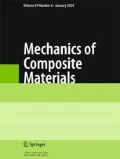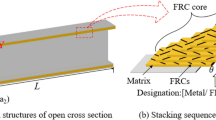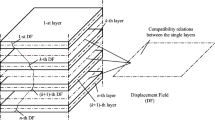Based on the classical laminate theory and proceeding from the necessary and sufficient conditions for the hygrothermal stability of materials, interlayer hybrid extension-twisting coupled free-layer laminates are designed. Then, analytical solutions for their yield and buckling strengths are derived. A mathematical model for the optimum design of composite structure is established to realize a synchronous multiobjective design of for interlayer hybrid extension-twisting coupled laminates. The finite-element method is used to simulate the hygrothermal effect, extension-twisting coupling, and buckling load of the laminates. Afterwards, an analysis of hygrothermal warping deformation and stiffness performance of the laminates is carried out to verify the suitability of the design method. Finally, the extension-twisting and bending-twisting coupled structures are constructed using the hybrid extension-twisting coupled laminates.






Similar content being viewed by others
References
O. Song and H. D. Kwon, “Modeling and vibration of a non-classical tilt-rotor wing system,” Aeronautical Journal, 111, No. 1119, 285-295 (2007).
J. Li and D. K. Li, “Multi-objective optimization of hygro-thermally curvature-stable antisymmetric laminates with extension-twisting coupling,” Journal of Mechanical Science and Technology, 28, No. 4, 1373-1380 (2014).
R. A. Haynes and E. A. Armanios, “New families of hygrothermally stable composite laminates with optimal extensiontwisting coupling,” AIAA Journal, 48, No. 12, 2954-2961 (2010).
A. Kaveh, A. Dadras and N. G. Malek, “Optimum stacking sequence design of composite laminates for maximum buckling load capacity using parameter-less optimization algorithms,” Engineering with Computers, 1-20 (2018).
M. Petrovic, T. Nomura, T. Yamada, et al., “Orthotropic material orientation optimization method in composite laminates,” Structural and Multidisciplinary Optimization, 57, No. 2, 815-828 (2018).
S. Kulkarni and B. Rosen, “Evaluation of the cost-effectiveness of hybrid composite laminates,” Journal of Aircraft, 14, No. 12, 1153-1154 (2013).
S. Adali, A. Richter, V. E. Verijenko, et al., “Optimal design of hybrid laminates with discrete ply angles for maximum buckling load and minimum cost,” Composite Structures, 32, No. 1-4, 409-415 (1995).
X. Y. Zhang, Y. Peng, Y. J. Xie, et al., “Hygrothermoelastic response of a hollow cylinder based on a coupled time-fractional heat and moisture transfer model,” Zeitschrift Für Angewandte Mathematik Und Physik Zamp, 70, No. 2, (2019).
Y. Peng, X. Y. Zhang, and X. F. Li, “Transient hygrothermoelastic response in a porous cylinder subjected to ramp-type heat-moisture loading,” Journal of Thermal Stresses, 42, 1499-1514 (2019).
R. A. Haynes and E. A. Armanios, “The challenge of achieving hygrothermal stability in composite laminates with optimal couplings,” International Journal of Engineering Science, 59 (2012).
C. B. York, “On extension-shearing coupled laminates,” Composite Structures, 120, 472-482 (2015).
M. C. S. Moreno, A. R. Gutiérrez, and J. L. M. Vicente, “First flexural and interlaminar shear failure in symmetric cross-ply carbon-fibre laminates with different response under tension and compression,” Composite Structures, 146, 62-68 (2016).
Y. Q. Huang and Q. S. Li, “Bending and buckling analysis of antisymmetric laminates using the moving least square differential quadrature method,” Computer Methods in Applied Mechanics & Engineering, 193, No. 33-35, 3471-3492 (2004).
D. Cui and D. K. Li, “Optimization of hybrid laminates with extension-shear coupling,” international journal of aerospace engineering, 1-12 (2018).
R. J. Cross, R. A. Haynes, and E. A. Armanios, “Families of hygrothermally stable asymmetric laminated composites,” Journal of Composite Materials, 42, No. 7, 697-716 (2008).
O. Erdal and F. O. Sonmez, “Optimum design of composite laminates for maximum buckling load capacity using simulated annealing,” Composite Structures, 71, No. 1,45-52 (2005).
J. Majak and S. Hannus, “Orientational design of anisotropic materials using the Hill and Tsai–Wu strength criteria,” Mech. Compos. Mater., 39, No. 6, 509-520 (2003).
J. Majak and M. Pohlak, “Optimal material orientation of linear and non-linear elastic 3D anisotropic materials,” Meccanica, 45, No. 5, 671–680 (2010).
J. Li and D. K. Li, “Extension-shear coupled laminates with immunity to hygro-thermal distortion,” Composite Structures, 123, 401-407 (2015).
M. M. Ali and W. X. Zhu, “A penalty function-based differential evolution algorithm for constrained global optimization,” Computational Optimization & Applications, 54, No. 3, 707-739 (2013).
S. C. Chou, Delamination of T300/5208 Graphite/Epoxy Laminates. Fracture of Composite Materials, Springer Netherlands (1982).
D. Cui and D. K. Li, “Bending-twisting coupled structures based on composite laminates with extension-shear coupling effect,” Composite Structures, 209, No. 1, 434-442 (2019).
Author information
Authors and Affiliations
Corresponding author
Additional information
Russian translation published in Mekhanika Kompozitnykh Materialov, Vol. 56, No. 5, pp. 881-904, September-October, 2020.
Rights and permissions
About this article
Cite this article
Cui, D., Li, D.K. An Adaptive Structure Based on Hybrid Extension-Twisting Coupled Laminates. Mech Compos Mater 56, 601–618 (2020). https://doi.org/10.1007/s11029-020-09907-0
Received:
Revised:
Published:
Issue Date:
DOI: https://doi.org/10.1007/s11029-020-09907-0




